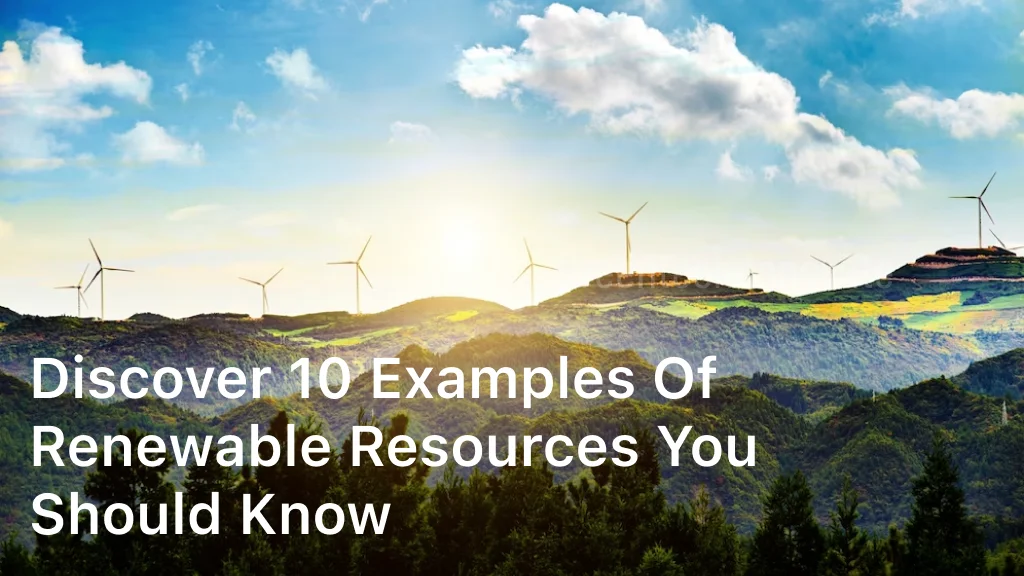
Greentechinnovate.com. 10 Examples of Renewable Resources You Should Know – Explore with us the top “10 Examples of Renewable Resources” shaping sustainable solutions in the U.S. Journey towards a greener future begins here!
As we continue to face the challenges of climate change, it’s more important than ever to find sustainable solutions for our energy needs. Renewable resources offer a promising path towards a greener future, and there are many examples of these resources that are currently being utilized in the United States.
From solar energy to wind power, hydropower to geothermal energy, there are a variety of renewable resources that offer clean and sustainable sources of power. By understanding these resources, we can work towards reducing our reliance on fossil fuels and creating a more sustainable energy mix.

10 examples of renewable resources
1. Solar Energy
The sun’s rays are harnessed using solar panels to generate electricity and heat water.
2. Wind Energy
Wind turbines convert the kinetic energy of the wind into electricity.
3. Hydropower
Energy is generated by harnessing the flow of water in rivers or dams to turn turbines.
4. Geothermal Energy
Heat from the Earth’s interior is utilized to generate electricity or provide direct heating.
5. Biomass
Organic materials such as wood, crop residues, and waste are used to produce energy through combustion or other conversion processes.
6. Tidal Energy
The rise and fall of tides are used to generate electricity through tidal power plants.
7. Ocean Thermal Energy
Temperature differences in ocean water are harnessed to generate power.
8. Hydrogen Fuel Cells
Hydrogen, often derived from renewable sources, is used in fuel cells to produce electricity with water as the byproduct.
9. Biofuels
Fuels derived from organic materials, such as ethanol from crops or biodiesel from vegetable oils.
10. Wave Energy
Energy from the motion of ocean waves is captured and converted into electricity.
These resources are considered renewable because they are naturally replenished and do not deplete over time when properly managed.
FAQ
What are renewable resources?
Renewable resources are natural resources that can replenish or regenerate over time. They are considered sustainable because their supply is not finite and can be continuously used without depleting the Earth’s resources.
Why are renewable resources important?
Renewable resources are important because they offer a sustainable and clean alternative to fossil fuels. They help reduce greenhouse gas emissions and combat climate change. Additionally, they promote energy independence and create new job opportunities in the renewable energy sector.
How many examples of renewable resources will be covered in this section?
This section will explore ten examples of renewable resources that are shaping sustainable solutions in the United States.
What is solar energy?
Solar energy is a prime example of a renewable resource. It harnesses the power of the sun using photovoltaic cells to convert sunlight into electricity. Solar panels are widely utilized in residential and commercial settings, enabling a sustainable and clean source of energy.
How does wind power work?
Wind power is another prominent renewable resource. Wind turbines capture the energy from wind and convert it into electricity. Wind farms are established in various parts of the country, providing a significant contribution to the renewable energy sector.
What is hydropower?
Hydropower makes use of the energy from flowing or falling water to generate electricity. Dams are constructed to harness the power of rivers, creating hydroelectricity. This renewable resource plays a crucial role in the U.S. energy mix.
How is geothermal energy generated?
Geothermal energy utilizes the heat from the Earth’s core to generate electricity. Geothermal power plants tap into underground reservoirs of steam or hot water to produce renewable energy. This sustainable resource is available in certain regions of the United States.




